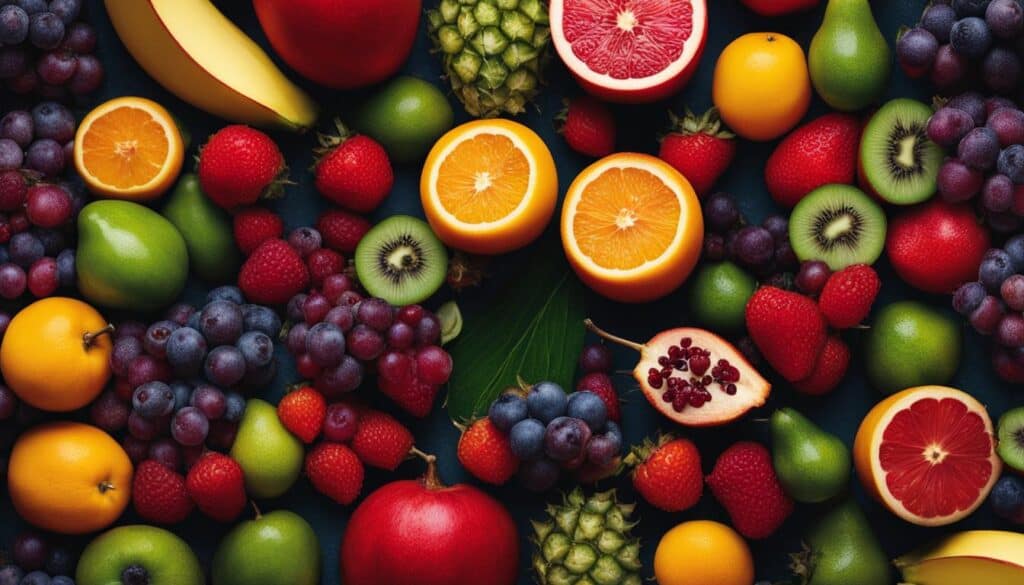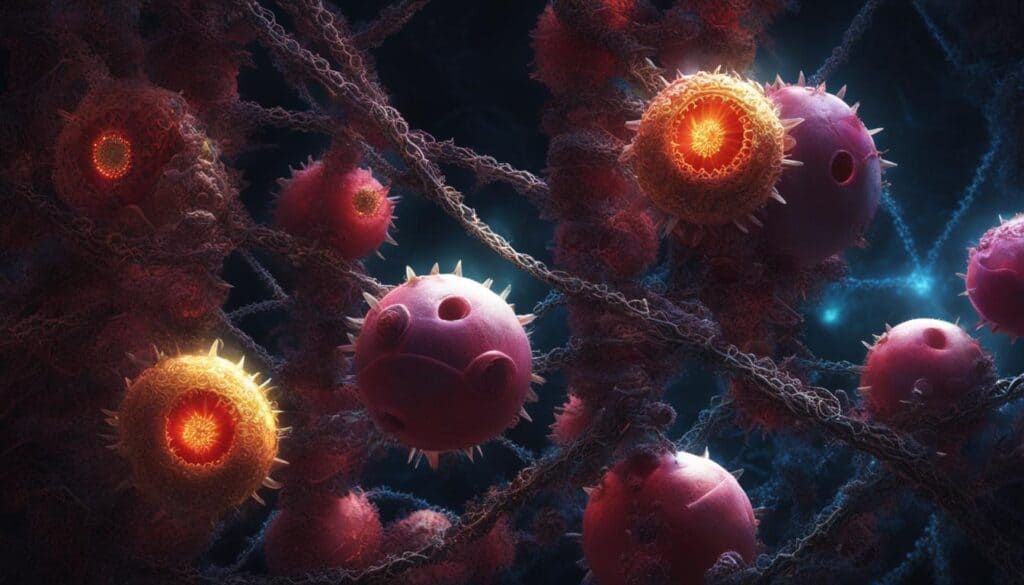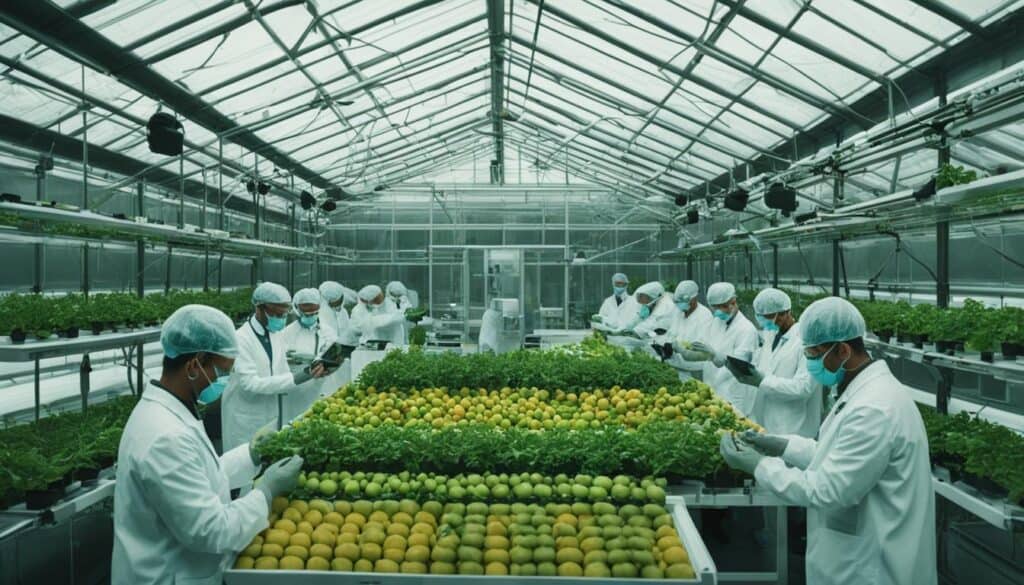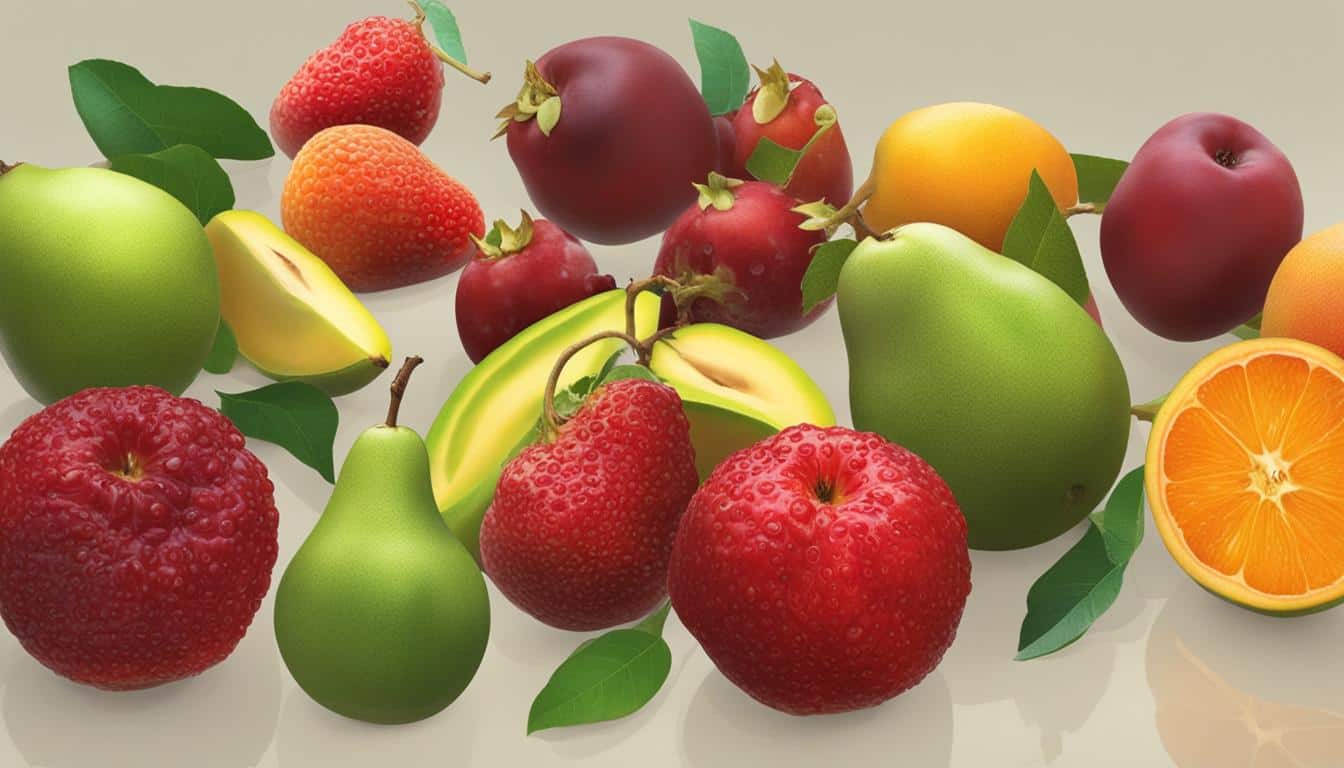Growing fruits without the need for pollination is a fascinating phenomenon known as fruit development without fertilization or parthenocarpy. This natural process allows fruits to develop and mature without the formation of seeds, resulting in the production of seedless fruits.
Through the manipulation of hormones and genetic factors, scientists have been able to induce parthenocarpic fruit development in various horticultural crops. This breakthrough in fruit science has revolutionized the food industry, as seedless fruits are highly valued for their convenience, improved fruit quality, and ease of processing.
Key Takeaways:
- Fruit development without fertilization, also known as parthenocarpy, allows fruits to grow and mature without pollination or seed formation.
- Manipulation of hormones and genetic factors can induce parthenocarpic fruit development in horticultural crops.
- Seedless fruits resulting from parthenocarpy are highly valued for their convenience and improved fruit quality.
- This natural process offers exciting possibilities for enhancing fruit production and meeting the demands of the growing population.
- Continued research in hormone treatments and genetic engineering techniques will drive future advancements in parthenocarpic fruit development.
What is Parthenocarpy?
Parthenocarpy is a fascinating natural process that allows fruit to develop without fertilization, resulting in the formation of seedless fruits. Unlike conventional fruit development, which requires pollination and the formation of seeds, parthenocarpy occurs asexually, enabling fruits to grow and mature without the need for fertilization. This phenomenon has been observed in various plant species and offers a unique way to enhance fruit quality and yield.
In parthenocarpic fruits, the seeds and seed cavities are replaced by edible pulp, resulting in larger fruit sizes and increased soluble solids content. This asexual fruit development not only affects the physical attributes of the fruit but also influences its taste and texture. Seedless fruits are often preferred in the food industry for their convenience, as they eliminate the need for seed removal.
“Parthenocarpy is a natural process that allows fruits to grow and mature without the need for pollination or the formation of seeds.”
Parthenocarpy has significant implications for horticulture, as it provides opportunities to improve fruit production and meet consumer demands. By understanding the mechanisms behind parthenocarpy, scientists can develop strategies to induce this process in different crops, enhancing their fruit quality and yield. Hormonal manipulation and genetic engineering techniques have been utilized to induce parthenocarpic fruit development, paving the way for further advancements in the field.
The Role of Hormones in Parthenocarpic Fruit Development
Hormones play a crucial role in the induction and regulation of parthenocarpic fruit development. Specifically, gibberellins (GAs), auxins, cytokinins, and abscisic acid (ABA) have been identified as key hormonal signals involved in this process. These hormones work together to ensure proper fruit growth and maturation, even in the absence of fertilization.
The exogenous application of hormones can effectively induce parthenocarpy in various horticultural crops. For instance, the use of gibberellins, auxins, and melatonin has been shown to stimulate fruit development without fertilization.
On the other hand, scientists have also explored the manipulation of endogenous hormone levels through genetic modification or hormone treatments. By altering the natural hormone balance within plants, researchers can enhance fruit set and development.
Hormonal Interactions
Hormones interact in complex ways to regulate parthenocarpic fruit development. Auxins, for example, promote fruit enlargement and cell division. Gibberellins, on the other hand, are responsible for elongation and maturation processes. Cytokinins play a role in cell division and cell differentiation, while abscisic acid is involved in fruit ripening and the maintenance of fruit quality.
Hormonal interactions are essential for the successful induction and regulation of parthenocarpy in horticultural crops. The crosstalk between these hormones ensures a coordinated and synchronized development of seedless fruits.
The Impact of Hormone Application on Fruit Development
The precise timing and dosage of hormone application are critical for achieving optimal fruit set and development. When applied exogenously, hormones can promote essential physiological processes in the developing fruits. For instance, gibberellins and auxins can stimulate cell division and elongation, leading to larger fruit size. Cytokinins can enhance cell differentiation and improve fruit quality, while abscisic acid contributes to fruit ripening and enhanced flavor.
By harnessing the power of hormone application, horticulturists can unlock the potential of parthenocarpy and produce seedless fruits with desirable characteristics.
Hormone Induction of Parthenocarpy in Selected Crops
| Crop | Hormones | Effects |
|---|---|---|
| Tomato | Auxins, gibberellins | Increased fruit size and seedlessness |
| Pear | Gibberellins | Enhanced fruit development and seedlessness |
| Cucumber | Gibberellins, auxins | Improved fruit quality and seedlessness |
| Apple | Auxins, cytokinins | Promoted fruit growth and seedlessness |
The application of hormones in specific crops demonstrates the diverse roles they play in parthenocarpic fruit development. Understanding these crop-specific hormonal requirements can enable targeted strategies to enhance fruit quality, size, and yield.
In the next section, we will delve into the genetic control of parthenocarpy and explore how advancements in genetic engineering techniques have further revolutionized fruit development without fertilization.
Genetic Control of Parthenocarpy
The development of parthenocarpy in horticultural crops can be controlled through genetic means. Researchers have identified specific genes involved in the regulation of fruit development without fertilization. Techniques such as gene silencing, mutation, and genome editing, including CRISPR/Cas9 technology, have been used to manipulate the expression of these genes and induce parthenocarpy in various plant species. Understanding the genetic control of parthenocarpy can lead to the development of new cultivars with enhanced fruit quality and yield.
Manipulating Genes for Parthenocarpy
In order to induce parthenocarpy in horticultural crops, scientists have focused on manipulating the genes responsible for this phenomenon. By selectively targeting and modifying these genes, researchers can control the fruit development process without the need for fertilization. Gene silencing, a technique that reduces or eliminates the expression of specific genes, has been particularly effective in inducing parthenocarpy. Through this process, scientists can hinder the production of seed-developing proteins, allowing for the development of seedless fruits.
Mutations in specific genes have also been found to play a crucial role in parthenocarpy. Researchers have identified mutations that disrupt the normal processes of pollination and fertilization, resulting in fruit development without seed formation. By understanding the underlying mutations and their effects, scientists can enhance fruit quality and yield through selective breeding.

Advancements in Genome Editing
Recent advancements in genome editing techniques, such as CRISPR/Cas9 technology, have revolutionized the field of genetic control in parthenocarpy. This powerful tool allows researchers to precisely edit the DNA sequence of specific genes, opening up new possibilities for inducing parthenocarpic fruit development. By targeting and modifying key genes involved in fruit development without fertilization, scientists can enhance the expression of parthenocarpy and improve fruit quality and yield.
Genome editing techniques not only enable precise modifications but also offer the potential for faster and more efficient breeding. With the ability to manipulate genes directly, scientists can accelerate the development of new cultivars with desired parthenocarpic traits, allowing for more efficient and sustainable horticultural practices.
| Genetic Control Techniques | Advantages | Challenges |
|---|---|---|
| Gene silencing | – Induces parthenocarpy – Enhances fruit quality – Seedless fruit development | – Identification of target genes – Efficient gene delivery |
| Mutation | – Disruption of seed development – Enhanced fruit yield – Seedless fruit production | – Identification of beneficial mutations – Isolation of mutant plants |
| Genome editing | – Precise modifications – Faster breeding – Desired parthenocarpic traits | – Off-target effects – Ethical considerations – Regulatory frameworks |
Genetic control of parthenocarpy holds immense potential for improving fruit quality, increasing yield, and meeting the demands of the growing population. By unraveling the intricate genetic mechanisms involved in fruit development without fertilization, scientists can develop innovative strategies for enhancing horticultural practices and cultivating crops with desirable traits.
Evolutionary Origin of Parthenocarpy
The evolutionary origin of parthenocarpy can be traced back to the development of ovules and the transition from flower to seed set in angiosperms. In the process of seed formation, ovules undergo various changes to facilitate fertilization and seed development. However, in some cases, these developmental processes can be altered, leading to fruit development without fertilization. This phenomenon, known as parthenocarpy, has evolved as a strategy for plants to ensure fruit production even in the absence of pollination.
One key aspect of the evolutionary origin of parthenocarpy is the modification of ovule development. Changes in ovule structure and integument development have been observed in plants exhibiting parthenocarpic fruit development. These changes allow for the initiation of fruit development without the need for fertilization. By bypassing the normal reproductive process, plants can produce fruit even under unfavorable pollination conditions.
In addition to ovule development, epigenetic regulation has also been implicated in the evolution of parthenocarpy. Epigenetic modifications, such as DNA methylation and histone modifications, play a crucial role in regulating gene expression during the transition from flower to seed set. These modifications can influence the development of seedless fruits by affecting the expression of genes involved in fruit development without fertilization.
| Factors | Description |
|---|---|
| Ovule development | Changes in ovule structure and integument development allow for fruit development without fertilization. |
| Epigenetic regulation | DNA methylation and histone modifications play a role in the evolution of parthenocarpy by affecting gene expression during fruit development. |
Understanding the evolutionary origin of parthenocarpy provides valuable insights into the expression of this trait in fruit crops. By studying the genetic, physiological, and ecological factors involved in parthenocarpy, scientists can gain a better understanding of how fruit development without fertilization has evolved and how it can be harnessed for horticultural purposes.
Hormonal Interactions in Parthenocarpy
The development of parthenocarpic fruit is a result of intricate hormonal interactions. Key hormones such as auxins, gibberellins, cytokinins, and abscisic acid play pivotal roles in regulating parthenocarpic fruit development. These hormones work together and influence each other’s levels to orchestrate fruit enlargement and maturation without fertilization. The interplay between these hormonal signals is crucial for the successful induction and control of parthenocarpy in diverse horticultural crops.
The Role of Auxins in Parthenocarpy
Auxins, a class of plant hormones, play a significant role in initiating and promoting parthenocarpic fruit development. They stimulate cell division and elongation, leading to fruit enlargement. By regulating gene expression, auxins contribute to the formation of seedless fruits with enhanced size and quality. The application of auxin treatments can induce parthenocarpy in various crop species, offering a means to enhance fruit yield and market value.
Gibberellins and Parthenocarpy
Gibberellins (GAs) are another group of hormones involved in parthenocarpic fruit development. They regulate cell division, elongation, and fruit growth, influencing the overall size and quality of the fruit. The exogenous application of GAs has been shown to induce parthenocarpy in several horticultural crops, providing a valuable technique for enhancing fruit production and meeting consumer demands.
Cytokinins’ Role in Parthenocarpy
Cytokinins, plant hormones responsible for cell division and differentiation, also play a role in parthenocarpic fruit development. They contribute to the growth and expansion of fruit tissues, promoting fruit enlargement and ultimately leading to the production of seedless fruits with desirable characteristics. Through their interaction with other hormones, cytokinins contribute to the regulation of parthenocarpy in various crop species.
Abscisic Acid’s Influence on Parthenocarpic Fruit Development
Abscisic acid (ABA), a plant hormone involved in stress responses and fruit maturation processes, also influences parthenocarpic fruit development. ABA regulates the synthesis of other hormones and can contribute to fruit enlargement and ripening in the absence of fertilization. Its precise role in parthenocarpy is still being explored, but it is intricately linked to hormonal interactions and fruit development processes.

In summary, hormonal interactions between auxins, gibberellins, cytokinins, and abscisic acid are essential for the successful induction and control of parthenocarpy. These hormones work together to regulate fruit enlargement and maturation without fertilization, leading to the development of seedless fruits with improved characteristics. By understanding and manipulating these hormonal interactions, scientists and horticulturists can enhance fruit quality, increase crop productivity, and meet the demands of a growing population.
Application of Hormones in Parthenocarpic Fruit Development
Hormones play a crucial role in inducing and regulating parthenocarpic fruit development in horticultural crops. By applying hormones exogenously, we can stimulate fruit growth without the need for fertilization. Gibberellins, auxins, cytokinins, and abscisic acid are the key hormonal signals used in this process.
Exogenous application of these hormones promotes cell division, elongation, and enlargement in developing fruits, leading to their maturation and ripening. However, it is important to carefully consider the timing and dosage of hormone application to ensure optimal fruit set and development.
Highlights:
- Hormones can be applied externally to induce parthenocarpic fruit development.
- Gibberellins, auxins, cytokinins, and abscisic acid are key hormones involved in this process.
- Exogenous application of hormones promotes fruit growth without fertilization.
- Precise timing and dosage are critical for achieving optimal fruit set and development.
Applying hormones to horticultural crops allows us to enhance fruit development without the need for pollination. Through hormone manipulation, we can unlock the potential for seedless fruits and improve overall fruit quality and yield. By continuing to explore the role of hormones in parthenocarpy, we can advance the field of horticulture and meet the growing demands for delicious, high-quality produce.
Role of Hormones in Specific Crops
The role of hormones in parthenocarpy varies among different horticultural crops. Understanding the specific hormonal requirements of these crops can aid in the development of targeted strategies for enhancing fruit quality and yield. Let’s take a closer look at how hormones play a role in specific crops:
Tomato
In tomatoes, auxins and gibberellins have been identified as key regulators of parthenocarpy. These hormones stimulate fruit growth and development without the need for fertilization. By manipulating the levels of auxins and gibberellins, researchers have successfully induced seedless fruit development in tomatoes.
Pear
In pear crops, the exogenous application of gibberellins has been proven effective in inducing seedless fruit development. By providing the plant with additional gibberellins, fruit growth is stimulated, resulting in the production of seedless pears.
Cucumber
Hormone-dependent parthenocarpic fruit development has also been observed in cucumber crops. The specific hormonal interactions involved in cucumber parthenocarpy are still under investigation, but it has been suggested that gibberellins and auxins may play key roles.
Apple
Apple trees have also shown hormone-dependent parthenocarpic fruit development. The hormonal regulation in apple parthenocarpy has not been fully elucidated, but studies suggest that auxins and gibberellins are involved in the process.
Capsicum
Capsicum, or bell pepper, is another crop that exhibits hormone-dependent parthenocarpic fruit development. While the exact hormonal interactions in capsicum parthenocarpy are not yet fully understood, it is believed that gibberellins and auxins are involved in promoting fruit growth without fertilization.
By studying the specific hormonal requirements of these crops, horticulturalists can develop targeted approaches to induce parthenocarpy and enhance fruit quality and yield in specific crop species.
Advances in Genetic Engineering for Parthenocarpy
Genetic engineering techniques have revolutionized the field of horticulture, offering exciting new possibilities for inducing parthenocarpy in crops. With gene manipulation tools like CRISPR/Cas9, scientists can now make precise modifications to the specific genes involved in fruit development without fertilization.
By targeting and editing these genes, we can enhance the expression of parthenocarpy and unlock its potential to improve fruit quality and yield. The development of genetically modified cultivars with improved parthenocarpic traits holds great promise for the future of horticulture.
| Advantages of Genetic Engineering for Parthenocarpy | Challenges of Genetic Engineering for Parthenocarpy |
|---|---|
|
|
Genetic engineering techniques have shown great promise in improving fruit development without fertilization, but they also pose challenges that must be carefully addressed. Ethical concerns surrounding genetically modified crops, potential effects on biodiversity, and safety and regulatory considerations are important factors that need to be taken into account.
By navigating these challenges and maximizing the benefits of genetic engineering, we can create a future where parthenocarpy plays a key role in enhancing fruit quality, meeting the demands of a growing population, and contributing to sustainable horticultural practices.

With further advancements in gene editing technologies, scientists are continuously expanding our understanding of the complex genetic mechanisms driving parthenocarpy. By unraveling the intricate web of genetic interactions that govern fruit development, we can unlock new opportunities for improving crop productivity and resilience.
As a genetic engineer, my passion lies in harnessing the power of gene manipulation to unlock the full potential of parthenocarpy. By modifying specific genes with precision, we can enhance fruit quality, increase crop yield, and contribute to a more sustainable future. The possibilities are endless, and I am excited to be at the forefront of these cutting-edge advancements.
Future Perspectives on Parthenocarpy
Parthenocarpy, the development of fruits without fertilization, holds immense potential for enhancing fruit quality and increasing crop yield in horticultural production. As scientists continue to uncover the underlying mechanisms and genetic control of parthenocarpic fruit development, exciting future perspectives arise.
One of the key areas of focus for future research is the optimization of hormone treatments and genetic engineering techniques. By fine-tuning the application of hormones and further understanding their interactions, higher levels of parthenocarpy can be achieved in different crop species. This will lead to the production of a greater quantity of seedless fruits, which are highly valued for their convenience and appeal to consumers.
Gaining a deeper understanding of the genetic control of parthenocarpy also opens up possibilities for developing innovative strategies. By precisely manipulating gene expression using advanced genetic engineering tools such as CRISPR/Cas9, scientists can enhance the expression of parthenocarpy and further improve fruit quality. Gene editing techniques offer the potential to develop genetically modified cultivars with superior traits, resulting in fruits that are not only seedless but also possess enhanced flavor, color, and shelf life.
Furthermore, as the global population continues to grow, meeting the increasing demand for high-quality fruits becomes crucial. Parthenocarpy provides a pathway to achieve higher crop yields, as it eliminates the need for pollination and seed formation. This enables plants to allocate more resources to fruit development, resulting in larger yields and greater economic returns.
Future Perspectives:
- Optimizing hormone treatments and genetic engineering techniques for increased parthenocarpy.
- Developing genetically modified cultivars with improved fruit quality through precise gene edits.
- Meeting the growing demand for high-quality fruits by maximizing crop yields through parthenocarpy.
Continued research in parthenocarpy will pave the way for transformative advancements in horticulture. The future holds exciting possibilities for leveraging this natural process to revolutionize fruit production and ensure sustainable food systems.

Advantages of Parthenocarpy in Horticultural Production
| Advantages | Explanation |
|---|---|
| Enhanced fruit quality | Seedless fruits are often larger, have increased sweetness, and higher soluble solids content. |
| Increased crop yield | Fruits can develop without seed formation, allowing plants to allocate more resources to fruit production, resulting in higher yields. |
| Ease of processing | Seedless fruits are preferred in food processing industries as they eliminate the need for seed removal, reducing processing time and costs. |
| Improved market appeal | Seedless fruits are often preferred by consumers due to their convenience, ease of consumption, and uniformity in size and appearance. |
Conclusion
Parthenocarpy, or fruit development without fertilization, is a fascinating natural process that has revolutionized the horticultural industry. Through the manipulation of hormones and genetic factors, scientists have unlocked the ability to induce parthenocarpic fruit development in various crops, leading to the production of seedless fruits with enhanced quality.
This remarkable breakthrough has not only expanded the range of fruit varieties available but has also simplified fruit processing and increased consumer satisfaction. The absence of seeds in parthenocarpic fruits reduces the need for labor-intensive seed removal, making them easier to work with for both consumers and food manufacturers.
Looking ahead, the future of parthenocarpy in horticulture holds great promise. Ongoing research in hormone treatments and genetic engineering techniques offers the potential for further advancements in fruit quality, yield, and crop production. By continuing to deepen our understanding of the mechanisms and genetic control of parthenocarpy, we can unlock new possibilities for meeting growing global demands for high-quality fruits.
FAQ
What is fruit development without fertilization?
Fruit development without fertilization, also known as parthenocarpy, is a natural process that allows fruits to develop and grow without the need for pollination or the formation of seeds.
What is the result of parthenocarpy?
Parthenocarpy results in the production of seedless fruits, where the seeds and seed cavities are replaced by edible pulp.
How is parthenocarpy induced?
Parthenocarpy can be induced through the manipulation of hormones and genetic factors in various horticultural crops.
What role do hormones play in parthenocarpic fruit development?
Hormones such as gibberellins, auxins, cytokinins, and abscisic acid play a crucial role in the induction and regulation of parthenocarpic fruit development.
How is the genetic control of parthenocarpy achieved?
Genetic control of parthenocarpy is achieved through techniques such as gene silencing, mutation, and genome editing, including CRISPR/Cas9 technology.
What is the evolutionary origin of parthenocarpy?
The evolutionary origin of parthenocarpy can be traced back to changes in ovule development and the loss of ovule integuments in angiosperms.
How do hormones interact in parthenocarpic fruit development?
Hormones such as auxins, gibberellins, cytokinins, and abscisic acid interact and regulate each other’s levels to promote fruit enlargement and maturation without fertilization.
Can hormones be applied to induce parthenocarpy in horticultural crops?
Yes, hormones such as gibberellins, auxins, cytokinins, and abscisic acid can be applied exogenously to stimulate fruit growth without fertilization.
Do different crops have different hormonal requirements for parthenocarpic fruit development?
Yes, different horticultural crops have specific hormonal requirements for parthenocarpic fruit development, such as tomatoes relying on auxins and gibberellins.
What advances have been made in genetic engineering for parthenocarpy?
Genetic engineering techniques, including gene manipulation and CRISPR/Cas9 technology, have allowed for precise modifications of specific genes involved in fruit development without fertilization.
What are the future perspectives on parthenocarpy?
The future of parthenocarpy in horticulture looks promising, with potential for improved fruit quality and increased crop yield through further advancements in hormone treatments and genetic engineering techniques.





Leave a Reply